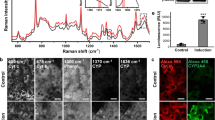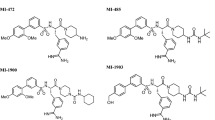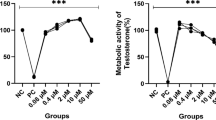Abstract
Aim:
Imrecoxib is a novel and moderately selective COX-2 inhibitor. The aim of the present in vitro investigation was to study the formation of the major metabolite 4′-carboxylic acid imrecoxib (M2) and identify the enzyme(s) involved in the reaction.
Methods:
The formation of M2 was studied in rat liver cytosol in the absence or presence of liver microsomes. The formed metabolite was identified and quantified by LC/MSn. In addition, to characterize the cytochrome P450 (CYP) isozymes involved in M2 formation, the effects of typical CYP inhibitors (such as ketoconazle, quinine, α-naphthoflavone, methylpyrazole, and cimetidine) on the formation rate of M2 were investigated.
Results:
The formation of M2 from 4′-hydroxymethyl imrecoxib (M4) was completely dependent on rat liver microsomes and NADPH. Enzyme kinetic studies demonstrated that the formation rate of M2 conformed to monophasic Michaelis-Menten kinetics. Additional experiments showed that the formation of M2 was induced significantly by dexamethasone and lowered by ketoconazole strongly and concentration-dependently. By comparison, other CYP inhibitors, such as α-naphthoflavone, cimetidine, quinine, and methylpyrazole had no inhibitory effects on this metabolic pathway.
Conclusion:
These biotransformation studies of M4 and imrecoxib in rat liver at the subcellular level showed that the formation of M2 occurs in rat liver microsomes and is NADPH-dependent. The reaction was mainly catalyzed by CYP 3A in untreated rats and in dexamethasone-induced rats. Other CYP, such as CYP 1A, 2C, 2D, and 2E, seem unlikely to participate in this metabolic pathway.
Similar content being viewed by others
Article PDF
References
Bai AP, Guo ZR, Hu WH, Shen F, Cheng GF . Design, synthesis and in vitro evaluation of a new class of novel cyclooxygenase-2 inhibitors: 3,4-diaryl-3-pyrrolin-2-ones. Chin Chem Lett 2001; 12: 775–8.
Shen F, Bai AP, Guo ZR, Cheng GF . Inhibitory effect of 3,4-diaryl-3- pyrrolin-2-one derivatives on cyclooxygenase 1 and 2 in murine peritoneal macrophages. Acta Pharmacol Sin 2002; 23: 762–8.
Chen XH, Bai JY, Shen F, Bai AP, Guo ZR, Cheng GF . Imrecoxib: a novel and selective cyclooxygenase 2 inhibitor with anti-inflammatory effect. Acta Pharmacol Sin 2004; 25: 927–31.
Xu HY, Xie ZY, Zhang P, Sun J, Chu FM, Guo ZR, et al. Role of rat liver cytochrome P450 3A and 2D in the metabolism of imrecoxib. Acta Pharmacol Sin, 2005; 27: 372–80.
Vonbarhr C, Groth CG, Jansson H, Lundgren G, Lind M, Glaumann H . Drug metabolism in human liver in vitro: establishment of a human liver bank. Clin Pharmacol Ther 1980; 27: 711–25.
Lowry OH, Rosebrough NJ, Farr AL, Randall RJ . Protein measurement with the Folin phenol reagent. J Biol Chem 1951; 193: 265–75.
Omura T, Sato R . The carbon monoxide-binding pigment of liver microsomes. I. Evidence for its hemoprotein nature. J Biol Chem 1964; 239: 2370–8.
Yanaoka K, Tanigawara Y, Nakagawa T, Iga T . A pharmacokinetic analysis program (MULTI) for microcomputer. J Pharmacobio-Dyn 1981; 4: 879–85.
Sandberg M, Yasar U, Stromberg P, Hoog JO, Eliasson E . Oxidation of celecoxib by polymorphic cytochrome P450 2C9 and alcohol degydrogenase. Br J Clin Pharmacol 2002; 54: 423–9.
Yamazaki H . Rat cytochrome P450 1A and 3A enzymes involved in bioactivation of tegafui to 5-fluorouracil and autoinduced by tegafur in liver microsomes. Drug Metab Dispos 2001; 29: 794–7.
Szotakova B, Skalova L, Baliharova V, Dvorscakova M, Storkanova L, Sispera L, et al. Characterization of enzymes responsible for biotransformation of the new antileukotrienic drug quinlukast in rat liver microsomes and in primary cultures of rat hepatocytes. J Pharm Pharmacol 2004; 56: 205–12.
Heuman DM, Gallagher EJ, Barwick JL, Wlshourbagy NA, Guzelian PS . Immunochemical evidence for induction of a common form of hepatic cytochrome P450 in rats treated with pregnenolone-16-carbonitrile or other steroidal or non-steroidal agents. Mol Pharmacol 1982; 21: 753–60.
Kocarek TA, Schuetz EG, Strom SC, Fisher RA, Guzelian PS . Comparative analysis of cytochrome P4503A induction in primary cultures of rat, rabbit, and human hepatocytes. Drug Metab Dispos 1995; 23: 415–21.
Paul LD, Springer D, Staack RF, Kraemer T, Maurer HH . Cytoxhrome P450 isoenzymes involved in rat liver microsomal metabolism of californine and protopine. Eur J Pharmcol 2004; 485: 69–79.
Shimizu M, Matsushita R, Matsumoto Y, Fukuoka M . 4′-Hydroxylation of flurbiprofen by rat liver microsomes in fasting and feeding conditions. Biol Pharm Bull 2003; 26: 1448–54.
Szakacs T, Veres Z, Vereczkey L . Effect of phenobarbital and spironolactone treatment on the oxidative metabolism of anti-pyrine by rat liver microsomes. Pol J Pharmacol 2001; 53: 11–9.
Author information
Authors and Affiliations
Corresponding author
Additional information
Project supported by the National High Technology Research and Development Program of China (No 2003AA2Z347C)
Rights and permissions
About this article
Cite this article
Xu, Hy., Zhang, P., Gong, As. et al. Formation of 4′-carboxyl acid metabolite of imrecoxib by rat liver microsomes. Acta Pharmacol Sin 27, 506–512 (2006). https://doi.org/10.1111/j.1745-7254.2006.00312.x
Received:
Accepted:
Issue date:
DOI: https://doi.org/10.1111/j.1745-7254.2006.00312.x



